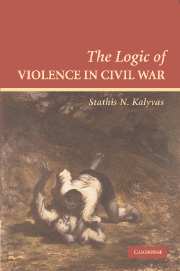Book contents
- Frontmatter
- Contents
- List of Tables and Figures
- Acknowledgments
- List of Abbreviations
- The Logic of Violence in Civil War
- INTRODUCTION
- 1 CONCEPTS
- 2 PATHOLOGIES
- 3 BARBARISM
- 4 A THEORY OF IRREGULAR WAR I
- 5 A THEORY OF IRREGULAR WAR II
- 6 A LOGIC OF INDISCRIMINATE VIOLENCE
- 7 A THEORY OF SELECTIVE VIOLENCE
- 8 EMPIRICS I
- 9 EMPIRICS II
- 10 INTIMACY
- 11 CLEAVAGE AND AGENCY
- CONCLUSION
- Appendix A Data Sources
- Appendix B Coding Protocols
- Appendix C Timeline of Conflicts
- References
- Index
- Titles in the series
7 - A THEORY OF SELECTIVE VIOLENCE
Published online by Cambridge University Press: 05 June 2012
- Frontmatter
- Contents
- List of Tables and Figures
- Acknowledgments
- List of Abbreviations
- The Logic of Violence in Civil War
- INTRODUCTION
- 1 CONCEPTS
- 2 PATHOLOGIES
- 3 BARBARISM
- 4 A THEORY OF IRREGULAR WAR I
- 5 A THEORY OF IRREGULAR WAR II
- 6 A LOGIC OF INDISCRIMINATE VIOLENCE
- 7 A THEORY OF SELECTIVE VIOLENCE
- 8 EMPIRICS I
- 9 EMPIRICS II
- 10 INTIMACY
- 11 CLEAVAGE AND AGENCY
- CONCLUSION
- Appendix A Data Sources
- Appendix B Coding Protocols
- Appendix C Timeline of Conflicts
- References
- Index
- Titles in the series
Summary
You've got to be on the ground to get the truth.
Lieutenant Colonel Greg Reilly, U.S. Army, IraqPeople talk and people die.
Eamon Collins, former IRA cadreWhat kills directly is the tongue.
A Nicaraguan officerThis chapter develops a theory of selective violence as a joint process. Political actors operating in a regime of fragmented sovereignty must rely on selective violence to deter defection (i.e., active collaboration with the rival actor), despite lacking the resources for monitoring the population. Selective violence entails the personalization of violence and requires information that is asymmetrically distributed between political actors and individual civilians. Within the institutional context defined by irregular war, violence results from the convergence of two distinct but related processes: the political actors' attempts to deter individual defection, and individuals' decision to provide information to political actors. I supply a political economy of the joint production of violence, formulate a model that captures the key aspects of the theory, and specify a set of empirical predictions.
The argument is as follows. Selective violence presupposes the ability to collect fine-grained information. The most effective way to collect it is to solicit it from individuals, which explains the ubiquity of the practice of denunciation in civil war. Denunciation is central to all civil wars, with the probable exception of a subset of civil wars where no actor attempts to obtain the collaboration of members of groups that allegedly support its rival and where all relevant information is in the public domain, conveyed by visible individual identities.
- Type
- Chapter
- Information
- The Logic of Violence in Civil War , pp. 173 - 209Publisher: Cambridge University PressPrint publication year: 2006



